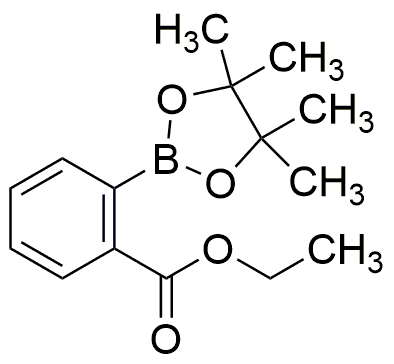Ethyl 2-(4,4,5,5-Tetramethyl-1,3,2-dioxaborolan-2-yl)benzoate is widely utilized in research focused on:
- Organic Synthesis: This compound serves as a versatile building block in the synthesis of complex organic molecules, making it invaluable for chemists developing new pharmaceuticals or agrochemicals.
- Medicinal Chemistry: It is used in the design of drug candidates, particularly in the development of compounds with enhanced bioactivity and selectivity, which is crucial for creating effective medications.
- Material Science: The compound finds applications in creating advanced materials, such as polymers and coatings, which benefit from its unique chemical properties, leading to improved durability and performance.
- Fluorescent Probes: It is utilized in the development of fluorescent probes for biological imaging, allowing researchers to visualize cellular processes with high specificity and sensitivity.
- Environmental Chemistry: This
General Information
Properties
Safety and Regulations
Applications
Ethyl 2-(4,4,5,5-Tetramethyl-1,3,2-dioxaborolan-2-yl)benzoate is widely utilized in research focused on:
- Organic Synthesis: This compound serves as a versatile building block in the synthesis of complex organic molecules, making it invaluable for chemists developing new pharmaceuticals or agrochemicals.
- Medicinal Chemistry: It is used in the design of drug candidates, particularly in the development of compounds with enhanced bioactivity and selectivity, which is crucial for creating effective medications.
- Material Science: The compound finds applications in creating advanced materials, such as polymers and coatings, which benefit from its unique chemical properties, leading to improved durability and performance.
- Fluorescent Probes: It is utilized in the development of fluorescent probes for biological imaging, allowing researchers to visualize cellular processes with high specificity and sensitivity.
- Environmental Chemistry: This
Documents
Safety Data Sheets (SDS)
The SDS provides comprehensive safety information on handling, storage, and disposal of the product.
Product Specification (PS)
The PS provides a comprehensive breakdown of the product’s properties, including chemical composition, physical state, purity, and storage requirements. It also details acceptable quality ranges and the product's intended applications.
Certificates of Analysis (COA)
Search for Certificates of Analysis (COA) by entering the products Lot Number. Lot and Batch Numbers can be found on a product’s label following the words ‘Lot’ or ‘Batch’.
*Catalog Number
*Lot Number
Certificates Of Origin (COO)
This COO confirms the country where the product was manufactured, and also details the materials and components used in it and whether it is derived from natural, synthetic, or other specific sources. This certificate may be required for customs, trade, and regulatory compliance.
*Catalog Number
*Lot Number
Safety Data Sheets (SDS)
The SDS provides comprehensive safety information on handling, storage, and disposal of the product.
DownloadProduct Specification (PS)
The PS provides a comprehensive breakdown of the product’s properties, including chemical composition, physical state, purity, and storage requirements. It also details acceptable quality ranges and the product's intended applications.
DownloadCertificates of Analysis (COA)
Search for Certificates of Analysis (COA) by entering the products Lot Number. Lot and Batch Numbers can be found on a product’s label following the words ‘Lot’ or ‘Batch’.
*Catalog Number
*Lot Number
Certificates Of Origin (COO)
This COO confirms the country where the product was manufactured, and also details the materials and components used in it and whether it is derived from natural, synthetic, or other specific sources. This certificate may be required for customs, trade, and regulatory compliance.


